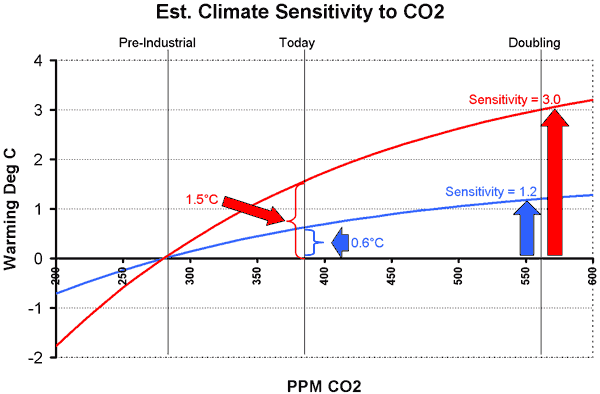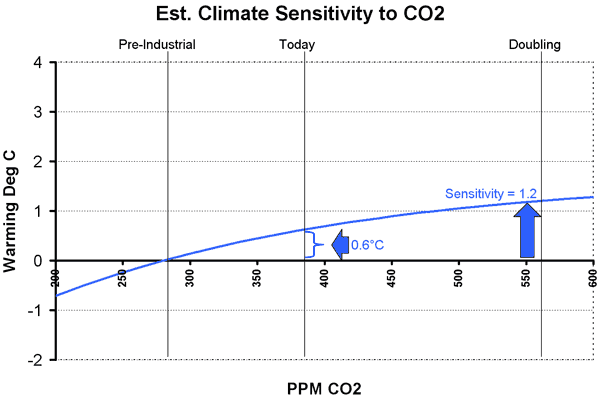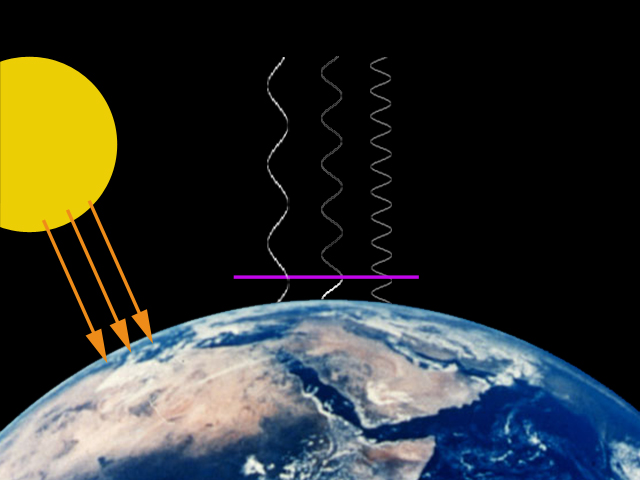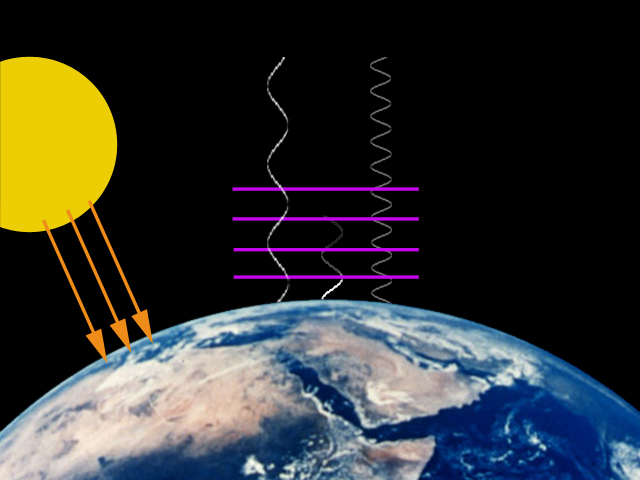When I have only 60 seconds to explain why I dont think man-made global warming will be catastrophic enough to warrant massively expensive CO2 abatement programs, this is my argument:
- CO2 does indeed absorb selected wavelengths of readiation returning to space from earth, having a warming effect on the atmosphere. However, this effect is a diminishing return — each successive increment of CO2 concentrations will have a much smaller effect on temperatures than the previous increment. Eventually, CO2 becomes nearly saturated in its ability to absorb radiation. The effect is much like painting a red room with white paint. The first coat covers a lot of red but some still shows through. Each additional coat will make the room progressively whiter, but each successive coat will have a less noticeable effects than the previous coat, until the room is just white and can’t get any whiter (the "layers" of CO2 are shown in pink below)
- In the 20th century, the UN IPCC claims Earth’s surface temperatures have increased by about a 0.6 degree Celsius (though there are some good reasons to think that biases in the installation of temperature instruments have exaggerated this apparent increase). To be simple (and generous), let’s assume all this 0.6C increase is due to man-made greenhouse gasses. Some may in fact have been due to natural effects, but some may also have been masked by man-made sulfate aerosols, so lets just call man-made warming to be 0.6C.
- Since the beginning of the industrial revolution, it is thought that man has increased atmospheric CO2 concentrations from 0.028% of the atmosphere to 0.038% of the atmosphere. Since scientists often talk about the effect of a doubling of CO2, this historic rise in CO2 is 36% of a doubling.
- Using simple math, we see that if temperatures have risen 0.6C due to 36% of a doubling, we might expect them to rise by 1.67C for a full doubling to 0.056% of the atmosphere. But this assumes that the rise is linear — and we already said (and no one denies) that it is in fact a diminishing return relationship. Using a truer form of the curve, a 0.6C historic rise for 36% of a doubling implies a full doubling would raise temperatures by about 1.2C, or about 0.6C more than we have seen to date (see chart below). This means that the magnitude of global warming in the next century might be about what we have seen (and apparently survived) since 1900.
- Obviously, there is some kind of disconnect here. The IPCC predicts temperature increases in the next century of 4-8 degrees C. Big difference. In fact, the IPCC predicts we will get a 0.5C rise in just 20 years, not 70-100. Whereas we derived a climate sensitivity of 1.2 from empirical data, they arrive at numbers between 3 and 4 or even higher for sensitivity. The chart below shows that to believe sensitivity is 3, we would have to have seen temperature rises due to man historically of 1.5C, which nobody believes.

So how do they get accelerating temperatures from what they admit to be a diminishing return relation between CO2 concentration and temperature? And for which there is no empirical evidence? Answer: Positive feedback.
- Almost every process you can think of in nature operates by negative feedback. Roll a ball, and eventually friction and wind resistance bring it to a stop. Negative feedback is a ball in the bottom of a bowl; positive feedback is a ball perched precariously at the time of a mountain. Positive feedback breeds instability, and processes that operate by positive feedback are dangerous, and usually end up in extreme states — these processes tend to "run away" like the ball rolling down the hill. Nuclear fission, for example, is a positive feedback process. We should be happy there are not more positive feedback processes on our planet. Current man-made global warming theory, however, asserts that our climate is dominated by positive feedback. The IPCC posits that a small increase in temperature from CO2 is multiplied 2,3,4 times or more by positive feedbacks like humidity and ice albedo.
- There are three problems with these assumptions about positive feedback. One, there is no empirical evidence at all that positive feedbacks in climate dominate negative feedbacks. The 20th century temperature numbers we discussed above show no evidence of these feedbacks. Since we used empirical numbers to calculate the sensitivity, it is already net of any feedbacks. Two, the long-term temperature record demonstrates that positive feedbacks can’t dominate, because past increases in temperature and CO2 have not run away. And three, characterizations of stable natural processes as being dominated by positive feedback should offend the intuition and common sense of any scientist.
- An expected 21st century increase of 0.5 or even 1 degree C does not justify the massive imposed government interventions that will be costly both in dollars and lost freedoms. In particular, the developing world will be far better off hotter by a degree and richer than it would be cooler and poorer. This is particularly true since sources like an Inconvenient Truth wildly exaggerate the negative effects of global warming. There is no evidence tornadoes or hurricanes or disease or extinction are increasing as the world warms, and man-made warming advocates generally ignore any potential positive effects of warming. As to rising sea levels, the IPCC predicts only a foot and a half of sea level rise even with 4 or more degrees of warming. Sea level rise from a half to one degree of warming would be measured at most in inches.

OK, so that was more than 60 seconds. But it is a lot less than 80 pages. There is a lot of complexity behind every one of these statements. If you are intrigued, or at least before you accuse me of missing something critical, see my longer paper on global warming skepticism first, where all these issues and much more (yes, including tree rings and cosmic rays) are discussed in more depth. You can also watch my free climate movie.



I haven’t read your longer article and I also am ignorant on the IPCC’s model. That being stated, it seems to me that there could also be a large Lag effect in your model. Meaning that you raise the CO2 today, and it might take 100 years for its effect to be fully felt. The ocean and the rest of the biosphere act as a giant heat sink that will take a while to heat up.
So as a thought experiment, if mankind all died off due to a plague and the CO2 stayed constant at 380 ppm wouldn’t the temperature continue to rise for some period and then stabilize? Your climate sensitivity model doesn’t seem to have any time lag in it.
Thanks for considering my naive question.
Newtronic – The atmosphere should heat up immediately, actually, which it has significantly been failing to do as expected. (Since the idea is that carbon dioxide in the atmosphere absorbs infrared radiation, getting hotter, and then reradiates that energy back downwards, as opposed to letting it pass through.) Surface air temperatures would suffer a lag time – which is why the troposphere is supposed to “lead” surface temperatures – but the current warming trends have been more heavily surface-side than they should have been. (No, the glitch that was corrected in satellite data does not eliminate the problem with the model, but merely reduces its scope.)
Lag for CO2 effects is a very interesting subject, because, historically, the lag has worked the other way around. Temperature shifts have led CO2 shifts – never the other way around.
More interestingly, and this is a point I haven’t heard addressed, high CO2 has never been sufficient in the past to keep temperature from declining – if it can’t even support temperatures, it’s highly unlikely it can increase them.
I have heard several stories about high temperatures causing CO2 increases instead of CO2 increases leading high temperatures and I agree with them. This was a really well done observation. It is very condensed, so I appreciate you putting the link to the longer reviews! Still decreasing my own consumption of fossil fuels lead me to get a robotic lawn mower to take care of my yard rather than a traditional gas powered one. Bamabots.com has some reviews and good ecological reasons to choose robotic over gas powered mowers.
Adirian : are you for real? How exactly is you not burning fossil fuels, but instead getting a power company to do it for you, helping the environment? If you really cared about the environment you would (a) not be buying devices with lead, cadmium, etc (b) get off your butt and use a manual human powered mower.
In response to Newtronic: Yes, there would be a temperature lag. You notice one every day- the air isn’t warmest at noon; the highest temperatures are reached about 2 PM, or 1/12 of a 24 hour day later.
The coldest winter temperatures aren’t at the winter solstice; the coldest temperatures are in January, about 1/12 of a year later. Likewise, warming by the sun over the 20th century might be expected to have a
1/12 century lag in temperature changes. Here’s a link to a posting by
astrophysicist Nir Shaviv criticizing the Lockwood and Frohlich paper:
http://motls.blogspot.com/2007/07/nir-shaviv-why-is-lockwood-and-frohlich.html
You also might find Nir Shaviv’s website informative.
http://www.sciencebits.com/ice-ages
– A. McIntire
You raise some interesting arguments here. Can you cite any published scientific studies in support? The scientific research I’ve read explains that we will see an additional .5 degrees celsius of warming due to the radiative effect of our oceans. Once this is taken into account, the numbers in your future estimates change significantly. Also, the scientific studies I’ve read explain that the CO2 in our atmosphere is far from a saturation point in UV absorption.
Climate skeptics make a lot of interesting points, but without scientific research to support them, they’re really just propaganda. Show me something to convince me that you’re right… please!
The above highlights the whole problem. The climate is a system with too much inherent variability to make accurate predictions given the data we have. This is something that the IPCC scientists are
entirely honest about and frustrated by if you read their own conclusions- not the UN’s or Al Gore’s
I think the key point in the article is about the positive(+)feedback. No one maintains that Co2 can directly affect temperatures in any meaningful way- it’s all in the +feedback. the combined systems of- ice,algea,photosynthesis,air/water currents,clouds, etc etc are too complex by far to be accurately represented by pure mathematics- (the way you can predict a comet hitting jupiter for example) it requires a computer program. Now the problem is that even if you were to make the fantastic assumption that this program models the planet earth perfectly- there is no way to verify that it does- until it demonstrates reliable accuracy in it’s predictions, this has not happened yet.
It’s an interesting envelope-back analysis, and one that I’ll probably be keeping in mind. But color me unimpressed by “One, there is no empirical evidence at all that positive feedbacks in climate dominate negative feedbacks.”
We have abundant evidence that the climate spontaneously bounces around a lot. That’s one of the reasons why periodically I look into this controversy, in fact. Every time I encounter an argument which doesn’t adequately acknowledge the way that that confounds the interpretation of temperature trends in the last century, it becomes harder for me to avoid bouncing off the walls again. Now your analysis has me bouncing too by seemingly underappreciating the historical fluctuations, though in a somewhat subtler way.
To my (nonexpert) knowledge there is no known simple obvious back-of-the-envelope-suitable direct cause for the Ice Ages, Little and Big. (If you know one, it’d’ve helped if you’d mentioned it…) I’ve heard causes which sound possible. But as far as I know, it’s not a settled matter that the Ice-Age-sized temperature fluctuations were simply a passive atmospheric response to large fluctuations which were created by positive feedback elsewhere (e.g., instabilities in the Sun causing large fluctuations in its output). The observed historical temperature fluctuations ought to be driven by positive feedback instabilities somewhere, and the atmosphere is on a very short list of obvious candidates for where.
Sure, when I look at a messy system which has been around long enough for transients to die, my first guess is that it’s going to be basically stable, not brimming over with positive feedback. But that’s just a first guess, weakly held. If I have a historical record of the system continuing to bounce all the hell over the place, my new first guess is that positive feedback ust often dominate negative feedback. Isn’t that normal?
Pick any other system about which you don’t know the details but do know that it booms and busts: stock prices, various kinds of animal populations, video footage of an unidentified missile’s terminal guidance going wild by more-or-less oscillating around the ideal trajectory, whatever. Do you not consider the booms and busts to be strong evidence that the system has important modes in which positive feedback dominates negative feedback? Or do you have a pointer to research results showing decisively that the Ice Age fluctuations aren’t evidence for atmospheric positive feedback because other fluctuations elsewhere (in solar output, whatever) are known to be large enough to explain the temperature fluctuations without positing atmospheric instabilities? If not, why aren’t the Ice Ages strong suggestive evidence for quite a lot of positive feedback in the atmosphere? The atmosphere seems to be on a short list of obvious suspects, and I don’t know of an alibi.